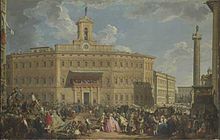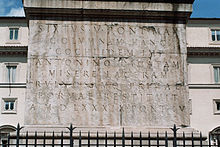- Column of Marcus Aurelius
-
The Column of Marcus Aurelius (Latin: Columna Centenaria Divorum Marci et Faustinae, Italian: Colonna di Marco Aurelio) is a Roman victory column in Piazza Colonna, Rome, Italy. It is a Doric column featuring a spiral relief: it was built in honour of Roman emperor Marcus Aurelius and modeled on Trajan's Column.
Contents
Construction
Because the original dedicatory inscription has been destroyed, it is not known whether it was built during the emperor’s reign (on the occasion of the triumph over the Marcomanni, Quadi and Sarmatians in the year 176) or after his death in 180; however, an inscription found in the vicinity attests that the column was completed by 193.
In terms of the topography of ancient Rome, the column stood on the north part of the Campus Martius, in the centre of a square. This square was either between the temple of Hadrian (probably the Hadrianeum) and the temple of Marcus Aurelius (dedicated by his son Commodus, of which nothing now remains - it was probably on the site of Palazzo Wedekind), or within the latter’s sacred precinct, of which nothing remains. Nearby is the site where the emperor’s cremation occurred.
The column’s shaft is 29.62 m (about 100 feet) high, on a ca. 10.1 m high base, which in turn originally stood on a 3 m high platform - the column in total is 39.72 m.[1] About 3 metres of the base have been below ground level since the 1589 restoration.
The column consists of 27 or 28 blocks of Carrara marble, each of 3.7 m diameter, hollowed out whilst still at the quarry for a stairway of 190-200 steps within the column up to a platform at the top. Just as with Trajan’s Column, this stairway is illuminated through narrow slits into the relief.
Relief
 German council of war - considered an early evidence to what would become known as the Thing (assembly).
German council of war - considered an early evidence to what would become known as the Thing (assembly).
The spiral picture relief tells the story of Marcus Aurelius’ Danubian or Marcomannic wars, waged by him from 166 to his death. The story begins with the army crossing the river Danube, probably at Carnuntum. A Victory separates the accounts of two expeditions. The exact chronology of the events is disputed; however, the latest theory states that the expeditions against the Marcomanni and Quadi in the years 172 and 173 are in the lower half and the successes of the emperor over the Sarmatians in the years 174 and 175 in the upper half.
One particular episode portrayed is historically attested in Roman propaganda – the so-called "rain miracle in the territory of the Quadi", in which a god, answering a prayer from the emperor, rescues Roman troops by a terrible storm, a miracle later claimed by the Christians for the Christian God.[citation needed]
In spite of many similarities to Trajan’s column, the style is entirely different, a forerunner of the dramatic style of the 3rd century and closely related to the triumphal arch of Septimius Severus, erected soon after. The figures’ heads are disproportionately large so that the viewer can better interpret their facial expressions. The images are carved less finely than at Trajan’s Column, through drilling holes more deeply into the stone, so that they stand out better in a contrast of light and dark. As villages are burned down, women and children are captured and displaced, men are killed, the emotion, despair, and suffering of the "barbarians" in the war, are represented acutely in single scenes and in the figures’ facial expressions and gestures, whilst the emperor is represented as a protagonist, in control of his environment.
The symbolic language is altogether clearer and more expressive, if clumsier at first sight, and leaves a wholly different impression on the viewer to the whole artistic style of 100 to 150 as on Trajan’s column. There, cool and sober balance – here, drama and empathy. The pictorial language is unambiguous - imperial dominance and authority is emphasized, and its leadership is justified. Overall, it is an anticipation of the development of artistic style into late antiquity, and a first artistic expression of the crisis of the Roman empire that would worsen in the 3rd century.
Later history
In the Middle Ages, climbing the column was so popular that the right to charge the entrance fee was annually auctioned[citation needed], but it is no longer possible to do so today. Now the Column serves a centerpiece to the piazza in front of the Palazzo Chigi.
 The column, right, in the background of Panini's painting of the Palazzo Montecitorio, with the base of the Column of Antoninus Pius in the right foreground (1747).
The column, right, in the background of Panini's painting of the Palazzo Montecitorio, with the base of the Column of Antoninus Pius in the right foreground (1747).
Restoration
About 3 metres of the base have been below ground level since 1589 when, by order of pope Sixtus V, the whole column was restored by Domenico Fontana and adapted to the ground level of that time. Also a bronze statue of the apostle St. Paul was placed on the top platform, to go with that of St. Peter on Trajan’s Column (27 October 1588[2]). (Originally the top platform probably had a statue of Marcus Aurelius, but it had been already lost by the 16th century.) That adaptation also removed the damaged or destroyed original reliefs on the base of garland-carrying victories carrying and (on the side facing the via Flaminia ) representations of subjected barbarians, replacing them with the following inscription mistakenly calling this the column of Antoninus Pius, which is now recognised as lost:
SIXTVS V PONT MAX (Sixtus V, High Priest (or Supreme Pontiff), COLVMNAM HANC restored this spiral column, COCLIDEM IMP ANTONINO DICATAM dedicated to the emperor Antoninus, MISERE LACERAM sadly broken and ruinous, RVINOSAMQ(UE) PRIMAE into its original form. FORMAE RESTITVIT A. MDLXXXIX PONT IV 1589, 4th year of his pontificate.) Dimensions
- Height of base: 1.58 m[3]
- + Height of shaft: 26.49 m
- Typical height of drums: 1.559 m
- Diameter of shaft: 3.78 m
- + Height of capital: 1.55 m
- = Height of column proper: 29.62 m (~ 100 Roman feet)
- + Height of pedestal: ~ 10.1 m
- = Height of top of column above ground: ~ 39.72 m
See also
- Column of Antoninus Pius
- List of ancient spiral stairs
- Roman Architecture
- Trajan's Column
References
- ^ Height of shaft, base and above ground: Jones 2000, p. 220
- ^ Art in Renaissance Italy By John T. Paoletti, Gary M. Radke
- ^ All data from: Jones 2000, p. 220
Bibliography
- Beckmann, Martin (2011). The Column of Marcus Aurelius. University of North Carolina Press. ISBN 978-0-8078-3461-9.
- Beckmann, Martin (2002). "The 'Columnae Coc(h)lides' of Trajan and Marcus Aurelius". Phoenix (Classical Association of Canada) 56 (3/4): 348–357. doi:10.2307/1192605. JSTOR 1192605.
- Caprino, C.; A. M. Colini, G. Gatti, M. Pallottino, P. Romanelli (1955). La Colonna di Marco Aurelio.
- Coarelli, F. (2008). La Colonna di Marco Aurelio - The Column of Marcus Aurelius.
- Ferris, Iain (2009). Hate and War: The Column of Marcus Aurelius.
- Jones, Mark Wilson (2000). Principles of Roman Architecture. Yale University Press. ISBN 0-300-08138-3
- Rendina, Claudio (2000). Enciclopedia di Roma. Rome: Newton & Compton.
- Scheid, J.; V. Huet (2000). Autour de la colonne Aurélienne.
External links
- A photo of the column presently and how it might have appeared in Roman times
- A history of the Aurelian column
- Column of Antoninus Pius
- Column of Marcus Aurelius
- Column of Phocas
- Trajan's Column
List of Roman victory columns Coordinates: 41°54′03″N 12°28′47.5″E / 41.90083°N 12.479861°E
Categories:- 2nd-century architecture
- Monumental columns in Rome
- 2nd-century Roman sculptures
- Roman victory columns
Wikimedia Foundation. 2010.



